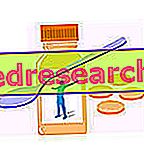By Dr. Giovanni Chetta
General index
WHAT IS A FOOD - ENERGY NEEDS - CHEMICAL COMPOSITION OF LIVING ORGANISMS - Carbohydrates (Sugars) - Lipids (Fats) - Proteins - Vitamins - Minerals - Water (H2O)
What is a food
Nutrition provides our body with the energy and the "building blocks" essential to life and beyond. As modern research has shown, in fact, there is a close connection between the brain and the belly, guaranteed both by the connection of the autonomic nervous system - enteric nervous system (vagus, pelvic and splanchnic nerve), and by the contemporary presence, in the brain and in the gastrointestinal tract, of the same group of hormones (somatostatin, neurotensin, opioids, etc.). The enteric brain is, in turn, in close connection with the endocrine system, very widespread within the gastrointestinal mucosa (APUD cells), and with the immune system, which presents here a wide lymphatic network. Our abdomen therefore appears as an important integrated neuroendocrine immune complex that performs functions with a large margin of autonomy but which, at the same time, suffers heavy influences both from the outside (food, visual inputs etc.) and from the inside (emotions, beliefs, habits, etc.).
Eating therefore not only serves to replenish energy and structural reserves but also serves to influence the general regulation systems of the organism (nervous, immune, endocrine system), including DNA, as epigenetics has shown. Only this can provide an idea of the enormous importance of good nutrition for psycho-physical health.
Energy Needs
Energy needs vary from individual to individual based on age, sex, activity, environment and physiological conditions. It is generally in the range of 2000-4000 Kcal.
The three most important metabolic sources for energy production are: blood glucose, cellular glycogen (present in liver and muscles), fatty acids of adipose tissue.
1 Kcal (kilocaloria) = 1 Cal = 4.184 kj (kilojoule)
Daily calorie requirement: 2000-4000 Kcal
Basal metabolism (MB): minimum energy consumption in absolute rest (indispensable for metabolic functions, respiration, circulation and cc.), In the supine position and upon awakening after a fast of at least 12 hours (protein for 24 hours), in condition of thermal neutrality. The basal metabolic rate varies with sex (in men it is higher), age, climate, work, consumption of exciting substances, type of nutrition (after 2-3h from protein intake + 30%, carbohydrates + 6%, lipids + 4%). In a sedentary individual it can represent 65-75% of the total energy requirement.
Performance in humans (% of energy introduced that turns into muscular work): 25%
1g of fat provides 9 Cal; absorption 97%
1g of carbohydrates provides 4 Cal; absorption 98%
1g of protein provides 4 Cal; absorption 91%

A peculiar aspect of man is the voluminous brain, its energy expenditure is 16 times that of muscle tissue per unit of weight; cerebral metabolism, in resting conditions, represents 20-25% of an adult's energy needs (8-10% more than other non-human primates).
In addition to energy, our body needs to take substances that reconstitute and reproduce those tissue cells that die every day.
Activities | Energy consumption |
Sleep | 80 Kcal / h |
Light activities (intellectual work, walking, bowls) | 100-200 Kcal / h |
Moderate activities (gardening, dancing) | 300 Kcal / h |
Heavy activities (swimming, athletics) | 500-800-Kcal / h |
Chemical composition of living organisms
Carbohydrates (Sugars)
Rich in plant foods (sugars, starch, cellulose). Important energy suppliers. If the reserves run out, muscle proteins are used to synthesize them. There are two reserves in our body: hepatic glycogen (controls glycemia) and muscle glycogen . They constitute a reduced energy reserve (10-12 hours, approx. 2000 calories). The reserve of glycogen in the adult is 350 g of which only 70-80g (= 20%) in the liver.
In a normal subject the plasma supplies 180g of glucose per day = 720 Kcal of which 80% is used by the cells of the nervous system (which therefore depends strictly on blood glucose for its metabolic needs). since the brain needs about 120g of glucose a day (in resting conditions it is 60% of the consumption of the whole organism), a fast of 24 h determines ca. the end of the reserves. After this period, the glucose needed by the brain is synthesized in the liver and kidney from non-glucose precursors (amino acids, lactic acid, odd chain fatty acids of carbon, glycerol) through gluconeogenesis. Only after a few days of fasting does the brain begin to use the ketone bodies as fuel (after 3 days they cover 1/3 energy needs of the brain with consequent renal loss of sodium ions, Na, for acid-base rebalancing).
One gram of sugar provides 4 Cal.
Lipids (Fats)
Main energy source, insulating layer, mechanical protection. Large energy reserve (adipose tissue accounts for 10-25% of body weight). They are placed at a distance from the muscles, so they can only be used for a few minutes (10-20 ") after exercise.
Triglyceride blood value = 72-170 mg / 100 ml
Unlike the other lipids, only 30-40% of the introduced cholesterol is absorbed (150-280 mg / 100 ml plasma, maximum intake 300 mg / g, membrane component, bile acid precursor, provitamin D and steroid hormones). Phytosterols, of vegetable origin, reduce their absorption. Cholesterol is not essential in the diet as it is regularly produced by the body (endogenous cholesterol). The two main chemical formulas of cholesterol: low-density lipoprotein (LDL) = bad cholesterol (cholesterol that goes to peripheral tissues), and high-density (HDL) = good cholesterol (cholesterol that goes from the peripheral tissues to the liver).
One gram of fat provides 9 Cal.
Protein
They have plastic and transport functions, enzymes. Digested and absorbed essentially in the small intestine after having been split into amino acids (22 aa of which 9 essential).
Recommended daily intake (RDA): 1g / kg body weight; higher consumption due to acute catabolism (surgical stress, severe trauma or debilitating disease).
Absorbed amino acids must be used immediately because they cannot accumulate in the body as such. Excessive introduction or reduction of protein synthesis creates problems as they increase the toxic end products of their metabolism (urea, uric acid, NH3, etc.), with overload of excretory organs (in particular, meat proteins are associated with other substances nitrogenous, purine, + additives + toxic substances due to cooking). Proteins have a more plastic and energy role.
One gram of protein provides 4 Cal.
Vitamins
Vitamins do not provide calories, they are bioregulators. They are essential (nowadays the specific syndromes for avitaminosis are rare, while the relative deficiencies that involve fatigue, a sense of malaise, headache, etc. are common).
Water-soluble vitamins: enzymatic cofactors, easily absorbed by the intestine, for most of them, the excessive quantity is eliminated by urine (Vit. C, B1, B2, B6, B12, PP, H, F, pantothenic acid, folic acid) .
Fat-soluble vitamins: absorbed in the intestine together with fats and then accumulated in the liver and adipose tissue in considerable quantities (risk of overdosing). They condition the integrity of cell membranes and subcellular particles; little alterable to temperature variations but sensitive to oxygen (Vit. A, D, E, K).
Mineral salts
Mineral salts do not provide calories but are activators of metabolic reactions and keep osmotic pressure constant. Many are in relationship to each other (the excess of one limits the absorption of the other or they have opposite actions). Today, relative deficiencies are possible.
Sodium (Na), Chlorine (Cl), Potasio (K), Calcium (Ca), Phosphorus (P), Magnesium (Mg), Iron (Fe), Zinc (Zn), Sulfur (Z), Iodine, Cobalt, Fluorine etc.
Water (H2O)
It does not provide calories but is an essential component. Represents approx. 60% body weight in adults. Its task is to ensure the thermal balance, hydrosaline, digestive and assimilative, depurative, etc.



